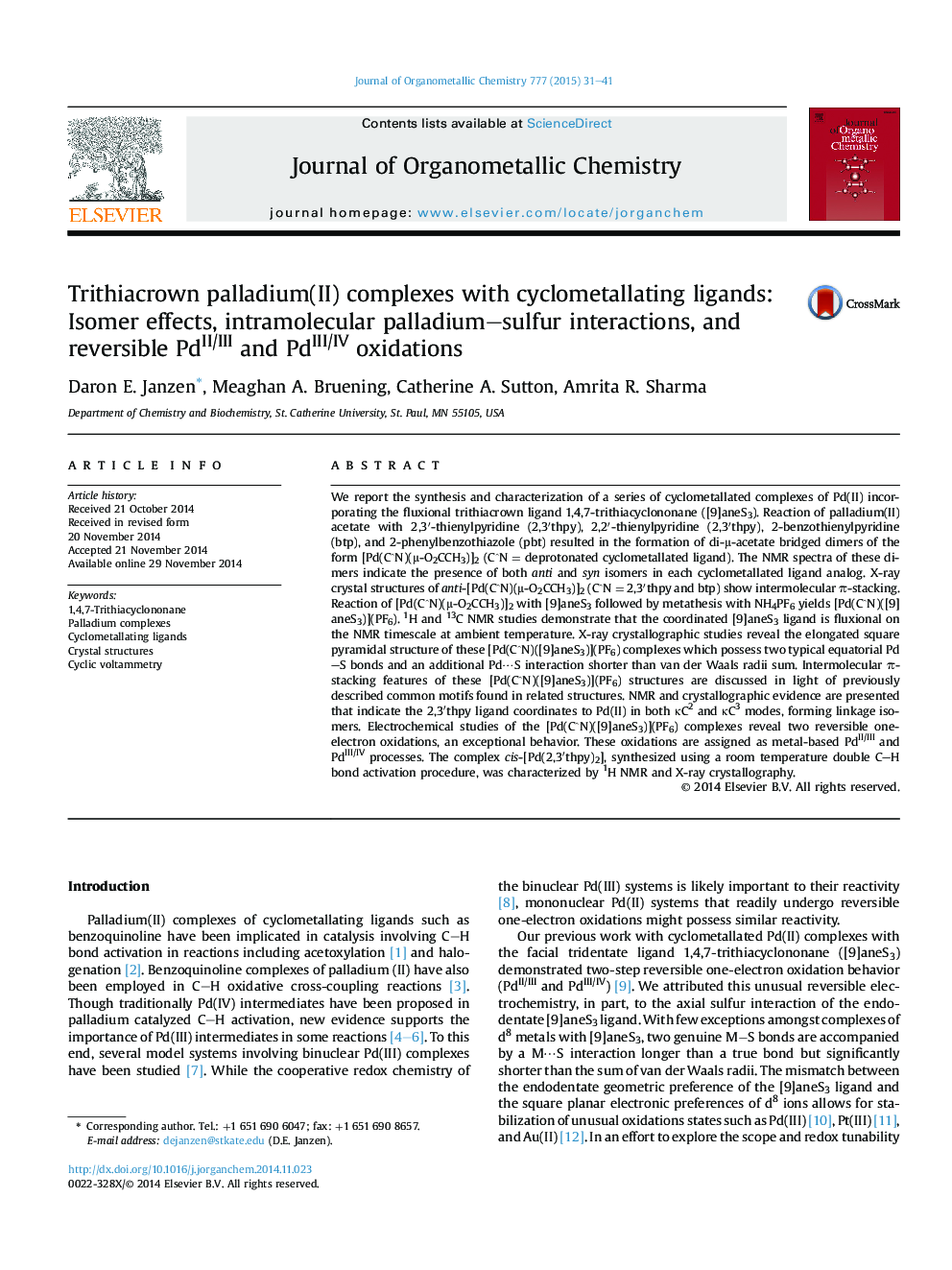| کد مقاله | کد نشریه | سال انتشار | مقاله انگلیسی | نسخه تمام متن |
|---|---|---|---|---|
| 1323546 | 1499865 | 2015 | 11 صفحه PDF | دانلود رایگان |

• A series of Pd(II) cyclometallated complexes are prepared in high yield using a low temperature synthesis.
• These complexes react with [9]aneS3 to form elongated square pyramidal structures with two Pd–S bonds and one longer intramolecular Pd⋯S interaction.
• Pd(II) complexes of 2,3′-thienylpyridine display κC2 and κC3 isomers as indicated by NMR and crystallography.
• Cyclic voltammetry of [Pd(CˆN)(9aneS3)](PF6) complexes indicate two sequential one-electron reversible oxidations.
• cis-[Pd(2,3′thpy)2] was synthesized using a room temperature double C–H activation method.
We report the synthesis and characterization of a series of cyclometallated complexes of Pd(II) incorporating the fluxional trithiacrown ligand 1,4,7-trithiacyclononane ([9]aneS3). Reaction of palladium(II) acetate with 2,3′-thienylpyridine (2,3′thpy), 2,2′-thienylpyridine (2,3′thpy), 2-benzothienylpyridine (btp), and 2-phenylbenzothiazole (pbt) resulted in the formation of di-μ-acetate bridged dimers of the form [Pd(CˆN)(μ-O2CCH3)]2 (CˆN = deprotonated cyclometallated ligand). The NMR spectra of these dimers indicate the presence of both anti and syn isomers in each cyclometallated ligand analog. X-ray crystal structures of anti-[Pd(CˆN)(μ-O2CCH3)]2 (CˆN = 2,3′thpy and btp) show intermolecular π-stacking. Reaction of [Pd(CˆN)(μ-O2CCH3)]2 with [9]aneS3 followed by metathesis with NH4PF6 yields [Pd(CˆN)([9]aneS3)](PF6). 1H and 13C NMR studies demonstrate that the coordinated [9]aneS3 ligand is fluxional on the NMR timescale at ambient temperature. X-ray crystallographic studies reveal the elongated square pyramidal structure of these [Pd(CˆN)([9]aneS3)](PF6) complexes which possess two typical equatorial Pd–S bonds and an additional Pd⋯S interaction shorter than van der Waals radii sum. Intermolecular π-stacking features of these [Pd(CˆN)([9]aneS3)](PF6) structures are discussed in light of previously described common motifs found in related structures. NMR and crystallographic evidence are presented that indicate the 2,3′thpy ligand coordinates to Pd(II) in both κC2 and κC3 modes, forming linkage isomers. Electrochemical studies of the [Pd(CˆN)([9]aneS3)](PF6) complexes reveal two reversible one-electron oxidations, an exceptional behavior. These oxidations are assigned as metal-based PdII/III and PdIII/IV processes. The complex cis-[Pd(2,3′thpy)2], synthesized using a room temperature double C–H bond activation procedure, was characterized by 1H NMR and X-ray crystallography.
Palladium(II) cyclometallated complexes with 1,4,7-trithiacyclononane form structures with two equatorial Au–S bonds and one long distance Au–S interaction that display two consecutive reversible one-electron oxidations.Figure optionsDownload as PowerPoint slide
Journal: Journal of Organometallic Chemistry - Volume 777, 1 February 2015, Pages 31–41